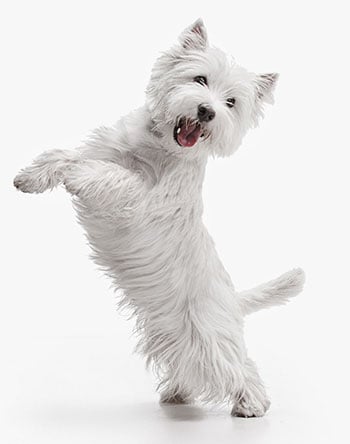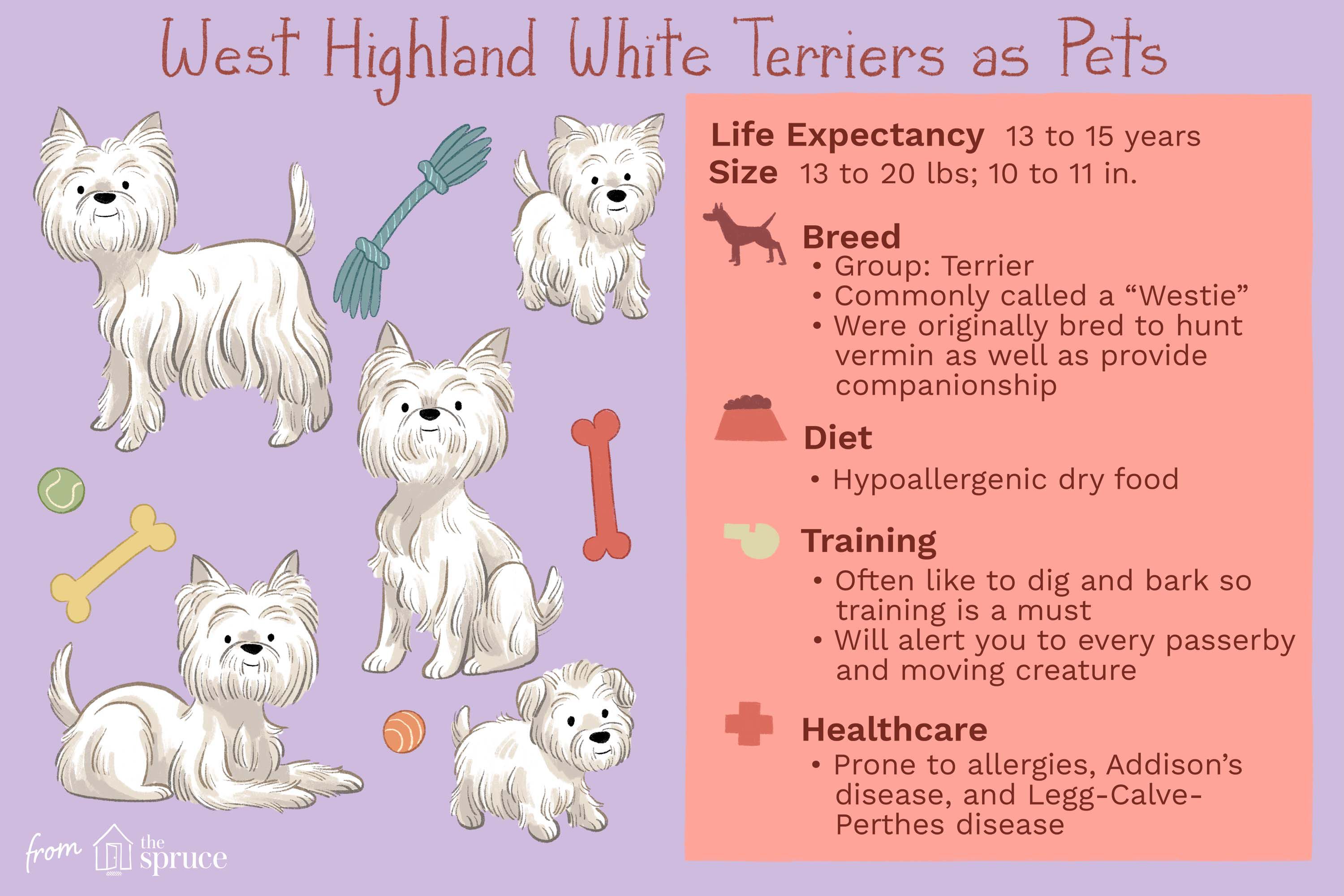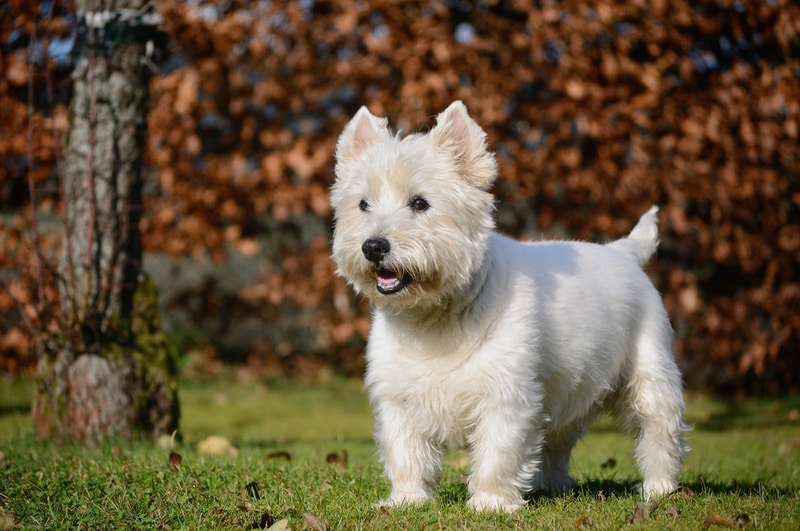
History and Origin of the West Highland White Terrier
Origins in Scotland
The West Highland White Terrier, affectionately called the Westie, proudly hails from the rugged and picturesque landscapes of Scotland. This charming terrier has roots that trace back to the 18th century, when the Scottish countryside was rife with vermin. Originally bred as earthdogs, Westies were especially valued for their ability to hunt and eliminate rats, foxes, and other bothersome pests.
An interesting anecdote reveals that Colonel Malcolm of Poltalloch played a significant role in the breed’s inception. After mistakenly shooting one of his beloved wheaten-colored Cairn Terriers during a hunt, he vowed to breed only white dogs for better visibility. This led to the development of the West Highland White Terrier, forever characterized by their iconic snowy-white coat.
Development of the Breed
Throughout their evolution, Westies were known by several names, including the Roseneath Terrier and the Poltalloch Terrier. These names highlighted key estates in Scotland’s noble history that contributed to the breed’s development. By the early 20th century, the breed received formal recognition from the Kennel Club in England, marking a significant milestone in their history.
Key milestones in Westie development include:
- 1906: The West Highland White Terrier was officially recognized by the Kennel Club.
- 1908: The American Kennel Club followed suit, solidifying the breed’s status in the U.S.
The breed’s tenacity and loyalty only enhanced their popularity, making them cherished companion animals that continue to stand out today.

Physical Characteristics of the West Highland White Terrier
Size and Weight
The West Highland White Terrier, often simply referred to as the Westie, is a compact yet robust pup that embodies both strength and charm. These little dogs are known for their sturdy builds, which make them well-suited for their historical role as earthdogs.
- Male Westies typically reach heights of 10 to 11 inches and weigh between 15 to 22 pounds.
- Female Westies, on the other hand, stand slightly shorter, growing up to 10 inches and weighing around 13 to 16 pounds.
Their small stature combined with a strong frame allows them to be agile hunters, always ready for an adventure! Despite their diminutive size, Westies pack a vibrant personality that can fill a room with joy and energy.
Coat and Grooming Needs
One of the most striking features of the West Highland White Terrier is its iconic white coat. The Westie’s double coat comprises a soft, short undercoat and a longer, harsher outer layer, which provides protection against harsh weather conditions.
To maintain their pristine appearance, Westies require regular grooming:
- Brushing: A few times a week helps remove loose hair and prevent matting.
- Bathing: Every few months is recommended, as their natural oils keep their coat healthy without excessive washing.
- Trimming: Focus on areas around the face and feet to keep them looking tidy.
With proper care, these adorable dogs can flaunt their beautiful coats and stay comfortable and healthy! Using the right grooming techniques makes a world of difference in ensuring that your Westie remains the show-stopping companion they were born to be.

Temperament and Personality Traits
Playful and Friendly Nature
The West Highland White Terrier, affectionately known as the Westie, is renowned for its playful and friendly nature. These little pups come packed with energy and always seem ready for an adventure.
- Curiosity at its Finest: The alertness of a Westie is simply remarkable. If there’s a new sound—a doorbell, a bark, or even children’s laughter—you’ll notice their ears perk up instantly, ready to explore.
- Playful Companions: Westies are social butterflies! They thrive on interaction, often engaging in playful antics that bring joy to everyone around them. Whether it’s a game of fetch or simply snuggling on the couch, they adore spending time with their families.
Their charming demeanor doesn’t just make them great pets; it also makes them excellent companions for children and other pets.
Training and Socialization
Despite their small stature, Westies have a surprisingly independent streak, which can pose a challenge during training. However, don’t let that deter you! With patience and consistency, they can learn a variety of commands and tricks.
- Start Early: Training should ideally begin during puppyhood to instill good habits early on. Consistent, short training sessions can help keep them engaged.
- Socialization is Key: Exposing your Westie to different people, environments, and other pets will help them become well-rounded companions. Positive experiences can reduce any potential behavioral issues later on.
A well-trained Westie not only enriches your life but also showcases the warm, intelligent spirit unique to this delightful breed!

Health Considerations for West Highland White Terriers
Common Health Issues
Like any breed, West Highland White Terriers are prone to certain health issues that prospective owners should be aware of. While these issues can vary, being informed helps ensure a healthier life for your Westie. Here are some common health concerns:
- Skin Issues: Westies often experience skin allergies, leading to itching and discomfort. Regular grooming and a clean environment can help minimize this.
- Craniomandibular Osteopathy: This is a bone growth condition affecting puppies, usually appearing between 4 to 8 months of age. Veterinary intervention is essential for pain management.
- Cataracts: These are eye problems that can develop over time, often seen earlier in Westies compared to other breeds. Surgical options are available to restore sight.
- Pulmonary Fibrosis: A serious lung condition, it may cause difficulty breathing and requires ongoing veterinary care if diagnosed.
Being aware of these conditions can help owners monitor their Westies’ health and catch any signs early.
Nutrition and Exercise Needs
Nutrition and exercise are crucial for maintaining a healthy Westie. They thrive on high-quality dog food, either commercial or home-prepared. The recommended daily intake is about 0.5 to 1.5 cups of dry food, divided into two meals.
- Avoid Overfeeding: Westies can easily gain weight, so it’s essential to monitor treats and portion sizes.
- Exercise Requirements: Although small, Westies are energetic! Daily walks and playtime are essential to keep them physically and mentally stimulated. Aim for at least 30 minutes of exercise each day, whether it’s playtime in the yard or a brisk walk around the neighborhood.
A well-nourished and exercised Westie is a happy, healthy companion, ready to fill your days with joy!

Living with a West Highland White Terrier
Suitable Living Arrangements
West Highland White Terriers, or Westies, are incredibly adaptable, making them suitable for a variety of living arrangements. Despite their compact size, they thrive best in environments that cater to their lively nature.
- Apartment Living: Westies can flourish in apartments, provided they receive enough exercise and stimulation. Daily walks are crucial, along with playtime to keep their spirits high.
- House with a Yard: A home with a securely fenced yard is ideal, allowing your Westie the freedom to explore and play while preventing them from darting after small critters.
It’s vital to ensure their living space is safe, as Westies are known to have a penchant for digging and chasing anything that moves. Keeping small pets out of reach or securely housed is also essential to prevent any unfortunate encounters.
Bonding and Activities
Bonding with your Westie is easy due to their friendly and affectionate nature. These dogs thrive on interaction and love activities that involve their families.
- Interactive Play: Engage your Westie in games like fetch or tug-of-war, which help strengthen your bond and provide much-needed exercise.
- Training Sessions: Utilize training as a bonding experience. Short, positive reinforcement sessions can be fun for both of you, reinforcing good behaviors and teaching new tricks.
Dogs like Westies thrive on routine and structure, as well as adventurous outings—whether a trip to the park or a simple car ride. Each moment spent together fosters a deeper connection, ensuring your Westie feels secure and loved in their forever home!


Famous West Highland White Terriers
Popular Westies in Media
The delightful West Highland White Terrier, fondly known as the Westie, has charmed audiences far and wide, not only with their adorable looks but also through various media appearances. One of the most notable appearances was in the Cesar dog food commercials, where their lovable personalities shone through, endearing the breed to pet owners everywhere. In addition to commercials, Westies have made their mark in films, most famously in “Lethal Weapon 3”, where a Westie played a pivotal role, showcasing their spirited nature and heartwarming companionship.
- Television: Westies also graced the screen in popular shows like “The Incredible Journey”, where their cleverness and adventurous spirit made them seek out friendship and protect their companions.
- Animation: Additionally, this breed has appeared in animated series, adding a touch of charm and humor as they navigate through various adventures.
Westie Celebrities
Many real-life Westies have also gained fame, becoming beloved pets to celebrities. For instance, Billie Jean King’s Westie, named Misty, often joined her at events, capturing hearts with their cuteness. Furthermore, numerous Westie owners share their pets’ lives on social media, showcasing their playful antics and adorable charm.
- Social Media Stars: Many Westies have become internet sensations, with dedicated pages that document their daily shenanigans, showcasing their playful and lovable personality.
Whether on-screen or off, Westies continue to capture hearts worldwide, proving that their charm knows no bounds!



Frequently Asked Questions about West Highland White Terriers
Shedding and Allergies
One common concern among prospective West Highland White Terrier owners is shedding, especially for those with allergies. Fortunately, Westies have a double coat that is designed to be relatively low-shedding compared to other breeds. This characteristic makes them more suitable for individuals who are sensitive to dog hair.
- Minimal Shedding: While Westies do shed, the amount is typically moderate. Regular grooming helps manage loose hairs and promotes a healthier coat.
- Allergy Considerations: If you or someone in your household suffers from allergies, it’s wise to spend time with a Westie before committing. Being around the breed can help determine if any allergic reactions occur.
Keep in mind that Westies can be prone to skin issues and allergies themselves, often manifesting as itchy skin. It’s essential to maintain a proper diet and regular veterinary check-ups to help minimize these health concerns.
Compatibility with Children and Other Pets
Westies can be excellent companions for families with children, thanks to their friendly and playful nature. However, as a dog owner, it’s crucial to supervise interactions with younger kids.
- Family-Friendly: Westies generally love engaging in play and can adapt well to family life, bringing joy to the household.
- Older Kids: They are usually more comfortable with older children who can understand and respect their space, reducing the likelihood of rough play.
Regarding other pets, Westies are social dogs and can coexist harmoniously with other dogs and even well-established cats. However, their inherent prey drive means that they may be inclined to chase smaller animals.
Ultimately, proper socialization from a young age, along with supervised playtime, helps ensure a happy living environment for all parties involved!

Leave a Reply